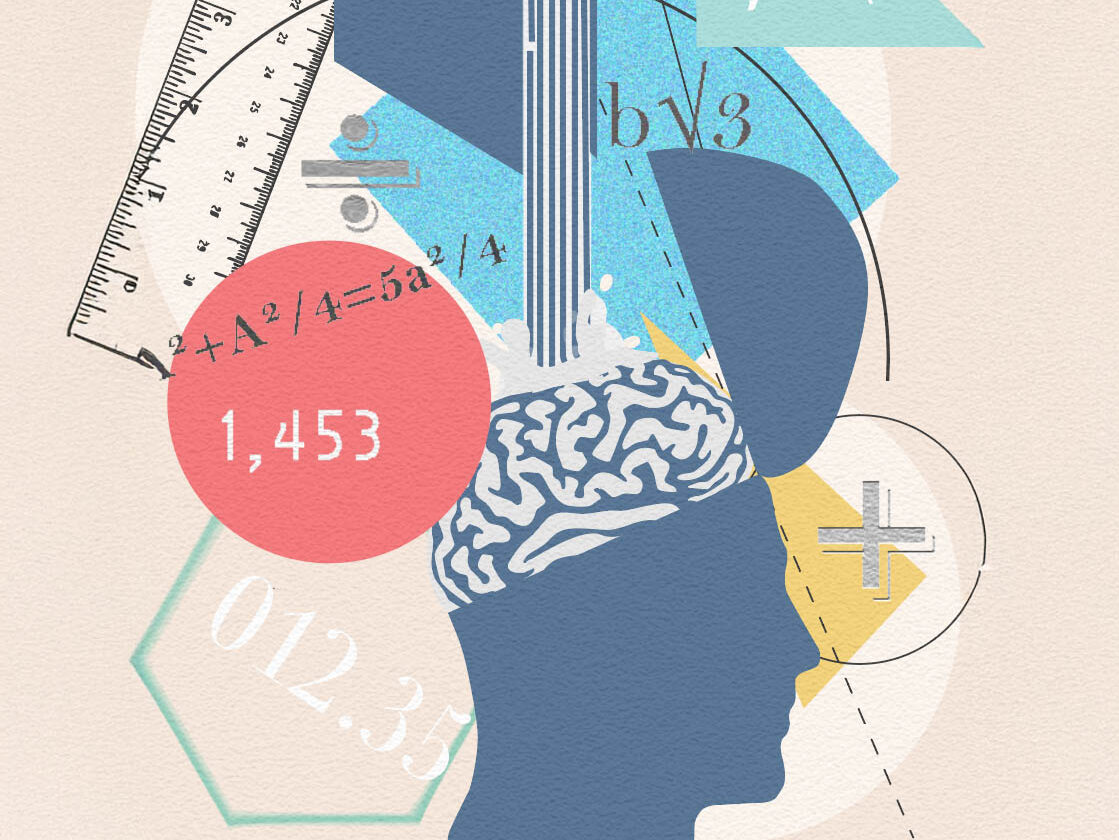The best ways to study, according to the latest neuroscience
By Cameron Bly
Artwork by Molly McGarvey
It’s 10 p.m. You should be asleep, but instead, you’re hunched over your desk, frantically reviewing your notes and completing as many practice problems as you can. You have a math test tomorrow, and you’re underprepared. You know you should have started studying earlier, but life got in the way—and now you’re doing whatever it takes not to flunk your exam.
Sound familiar? Whether you’re a student, former student or parent, you’re likely familiar with this scenario. Contrary to popular belief, however, science tells us that cramming the night before is far from the most effective way to study. “Your brain can only process a certain amount of information at once, and there is a whole process where that information gets encoded in a pathway,” explains Samantha Epstein, M.D., a neurologist at White Plains Hospital. “Then it’s stored in various parts of your brain so you can retrieve it later.”
Your brain’s ability to form new neurological pathways and retain information is known as neuroplasticity, and it is at the heart of what learning is, from a neurological standpoint (see page 28). But forming these pathways doesn’t happen overnight. It takes time and repetition to build and strengthen these pathways so they stick in your mind. “That’s why cramming can work for a certain amount of material, but not everything,” Epstein notes.
So, if cramming isn’t the answer, what is?
The secrets to effective studying
The truth is, there are no shortcuts when it comes to studying. “Real learning takes place when you’re engaging with the material over a longer period of time,” says Jane Emmer of Jane Emmer Coaching, which offers executive functioning coaching and academic support to students from sixth grade through college who live in Westchester and Manhattan. “And what I mean by engaging with the material is not just looking over your notes, but engaging in a multi-sensory way.”
A 2023 review of research from a variety of disciplines—including neuroscience, psychology, computer modeling and education—further confirms Emmer’s point. The findings, published in a paper titled “Learning with all your senses: Multimodal enrichment as the optimal learning strategy of the future,” conclude that using multiple senses—like sight, sound and movement—forces the regions of your brain that control perception and motor function to work together, enhancing your ability to learn. Emmer says multi-sensory engagement could include rewriting your notes and then reading them aloud. Or, you could record yourself summarizing your textbook pages in your own words and then listen to your summary while you take a walk. The more senses you use while studying, the better.
Another effective strategy is self-testing with the material you’ve studied. “It’s forced retrieval that consolidates a memory,” Epstein explains. “And each time you do that, you strengthen that memory and that pathway; this allows you to form an even more robust memory you can retrieve later.” While creating flashcards helps test your vocabulary or factual knowledge, turning to technology can be just as, if not more, effective, especially when it comes to more complex concepts. According to a study published in the February 2025 edition of Brain Sciences, artificial intelligence (AI) and machine learning (ML) can help you learn more efficiently by personalizing instruction to match your level of understanding. Plus, they can automatically adjust the lesson content, simplify complex concepts and offer immediate feedback. So if you’re struggling to grasp a concept taught in class, type it into your AI of choice and ask it to explain the concept to a 10-year-old (or an age at least several years younger than you are). Alternatively, if you understand the concepts but want to make sure you retain the material, try inputting what you’ve reviewed into an AI model and ask it to generate a practice test with the answers at the bottom of the test, or, as Emmer suggests, ask your AI of choice, “Did I miss anything?”
Timing is everything
Just as how you study matters, how long you study plays a role as well—and it might not be what you think. Instead of trying to cover everything at once, it’s more effective to study in small chunks. While the ideal length of time varies by person, Epstein says a good rule of thumb is to study in 30- to 45-minute intervals with breaks in between, adding that the older you get, the longer you may need, as neuroplasticity diminishes with age.
“The idea is, by taking a short break, your brain has a chance to reset,” Emmer explains. “If you sit down to study for two hours, it’s very difficult to be efficient and really learn for that entire two hours.” During a break, consider going for a run or taking a walk outside to boost your mood, promote neuroplasticity and enhance your information processing.
Taking these short breaks, commonly known as the Pomodoro Effect, is especially effective for students with ADHD, who also benefit from minimizing distractions and creating low-stress study environments. “If you have ADHD, you don’t want to be in a room with a lot of things on the wall or have too many screens in front of you,” Epstein advises. “Some people might feel more comfortable in certain spaces or with certain comfort items, but figuring out what it is for each individual and reproducing that space when they’re studying is important.”
One study tool doesn’t (and shouldn’t) fit all
Not all learners are the same. So naturally, not all learners should study the same way. Epstein says there are several ways to process information; some people learn best by seeing, while others learn best by hearing or doing things. “It’s really important to organize information in a way that makes sense to you so you can retrieve it intuitively as one unit versus separate, distinct facts,” she recommends.
If you’re more of a visual learner, educational YouTube videos can be a useful aid in reinforcing material. Auditory learners or those who struggle with reading, such as students with dyslexia, may benefit from text-to-speech apps that read content aloud. Using dyslexia-friendly fonts can also make reading easier and more accessible.
But, as mentioned earlier, no matter what type of learner you may be, it is important to vary how you study. “I think students look at themselves as bad studiers for two reasons: one, if they do poorly on a test, and two, if they start at the beginning of the year using a tool and then a month later, they find they’re not using it anymore, they see themselves as a failure,” says Emmer. “It’s okay to put one tool in the drawer and take out a new one. You’ve got to have other possibilities to draw on, because it makes learning more exciting and more fun. So, a visual learner could use auditory tools, and an auditory learner could use visual tools.”
Psychologists at Temple University and the University of Pittsburgh agree. Their research, published in March 2024 in the Proceedings of the National Academy of Sciences (PNAS), explains that varying how you study improves your memory. They found that simply reviewing the same content in the same way over and over isn’t sufficient. To truly enhance learning and retention, it’s essential to switch up your methods by mixing formats, tools and approaches. The more flexible and adaptive your study habits, the more effectively you’ll learn.
To keep things interesting, Emmer also encourages students to bring in their own curiosity to their learning. This could be formulating questions about the topic they’re studying or connecting their studies with their interests outside the classroom. For instance, a student who loves tennis and is studying early 1900s U.S. history might, as Emmer suggests, explore how tennis developed during that era, researching notable players or examining how cultural changes influenced the sport’s popularity, driving home the important dates and cultural phenomena they need to know for their test. And for parents, Emmer recommends learning parallel to their children, especially if their children are young. “If they’re reading a book in English class, read it alongside them so you can have discussions with them,” she suggests.
Ultimately, the goal is to create a flexible, personalized approach to studying—one that keeps students engaged and helps them make meaningful connections with what they’re trying to learn.
Start at the beginning
Great, so now you know the best ways to approach studying. But what’s the point if you’re waiting until the night before an exam to implement your new study habits? “A root cause of procrastination is task initiation,” Emmer notes. “And one reason people have a hard time initiating tasks is because they don’t know where to start.”
Most of the time, starting is simpler than you think. It could be doing the first problem of a math worksheet or starting an outline of key concepts the first day you begin a new unit. For college students with access to lecture slides in advance, reviewing them beforehand can provide a clearer understanding of what the professor will cover in class. But no matter what age you are, Emmer says mapping out your assignments on a timeline can be extremely useful.
“I was working with a college student who had dropped a couple of courses the semester before, and we started the semester by taking all of his syllabi and making a calendar of the entire semester,” she remembers. “He put his due dates and test dates immediately in the calendar, and then he started making some benchmarks on the assignments and the tests. And by looking at all four of his courses on this big calendar, he could see when he had the choice to do nothing or to really get engaged and start. That was really valuable for him.” By the end of the semester, Emmer’s student successfully implemented a calendar-based strategy, along with several other methods, and earned a spot on the dean’s list.
If there’s just one thing you take away from this article, let it be this: do that very first step, even if it’s just a small one—it will naturally lead you to accomplish the next.
This article was published in the September/October 2025 edition of Connect to Northern Westchester.









